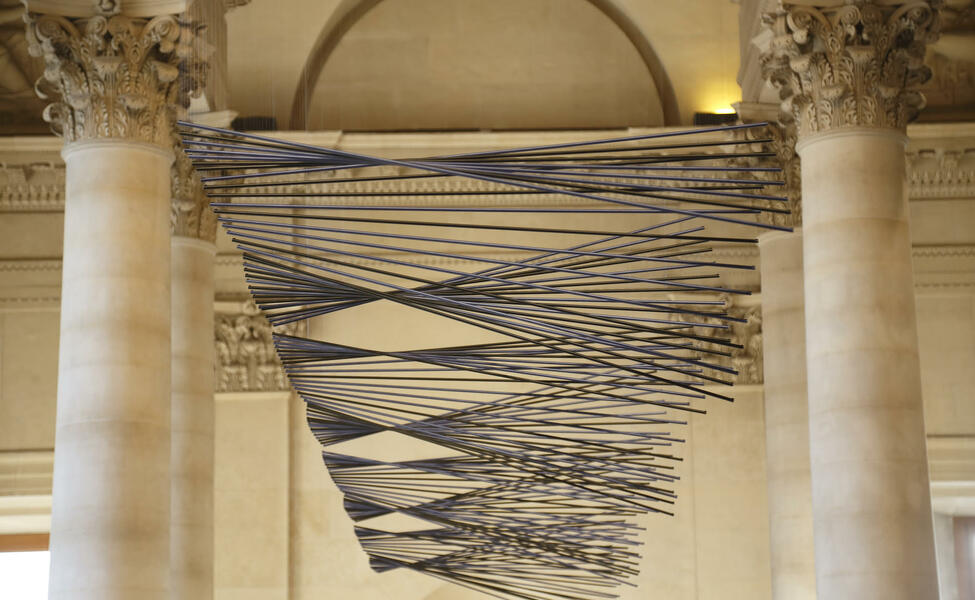ELIAS CRESPIN REDESIGNS THE GRAND SOUTHERN STAIRS OF THE LOUVRE MUSEUM
ELIAS CRESPIN REDESIGNS THE GRAND SOUTHERN STAIRS OF THE LOUVRE MUSEUM
The Louvre Museum has invited contemporary artist Elías Crespin to imagine a new permanent decoration for the palace on the occasion of the 30th anniversary of the Pyramid, thus resuming his commitment to the great public commissions

At the top of the southern staircase, Elías Crespin has created a kinetic work entitled L’Onde du Midi: 128 metal tubes hung by motorized threads, whose movement draws a subtle choreography. This project represents another milestone in the continuation of the Louvre's history, which since its creation, has been an ideal architectural framework to request painted or sculpted decorations from living artists. Inspirational place, the palace houses decorations made by George Braque, Anselm Kiefer, François Morellet or Cy Twombly. In this way, the Venezuelan artist follows in the footsteps of the great figures of contemporary art based in the Louvre.
Crespin's work, which belongs to the category of "Flexing Plane", consists of 128 cylindrical tubes parallelly aligned and suspended in the air by transparent threads. Celestial and aerial, this mobile sculpture has a horizontal rectangular plane almost ten meters long (1.50 x 9.50 m) when it is at rest. With its ceaseless movement, the sculpture seems to defy the laws of gravity. When set in space, it reaches an amplitude of 3 to 4.50 meters high, at a sequenced rhythm established by numerical algorithms. This wave choreography, in which mechanical linearity is absent, privileges slowness and favors contemplation and fascination. In front of it, as hypnotized, the viewer is immersed in a slow and graceful dance of infinite and unpredictable forms. Its random spatial configuration surprises without stopping, by means of expanding, flattening and diffracting forms; going from order to chaos, from simple to complex. The southern staircase is thus transformed into the stage of a silent ballet, whose function provides a pause in the visitor’s way. In L'Onde du Midi, creative intuition and scientific rigor come together to shape the laws of the universe, according to the interests of an artist who, at another stage of his life, was a computer engineer. «Forms and logic have always attracted me. I am sensitive to sensuality and the perception of things, such as appreciating a beautiful sunset. But there are also complex things that interest me: the functions, the properties of a circle or a triangle, the path that can result from a certain mathematical relationship,” he explains. Son of mathematicians and grandson of artists, Elías Crespin -Caracas, 1965- attended daily, since he was born, to the fruitful dialogue between mathematics and art. He grew up surrounded by the works of his grandparents, seeing the artistic practices of Gego and her husband, graphic designer, painter, draftsman and photographer Gerd Leufert. In 2002, he began to develop his first work, Electrokynetic Mesh I, which he presented in 2004, after two years of research. Since then, his mobile sculptures have integrated prestigious collections, including that of the Museum of Latin American Art of Buenos Aires, Houston Museum of Fine Arts, Museo del Barrio New York. Since 2008, he lives and works in Paris, where he is represented by the Denise René gallery. This exceptional event, which constitutes a great honor and recognition for the artist who now becomes the first alive Latin American artist to enter the collection of such an important institution, is the opportunity for the Denise René gallery to dedicate Elías Crespin his third monographic exhibition.


